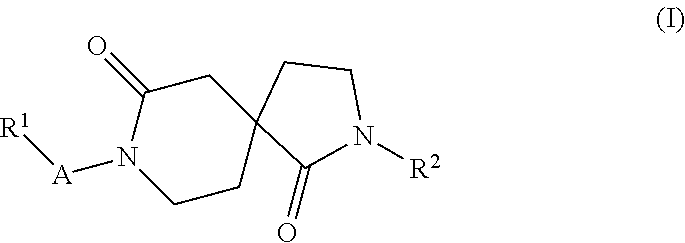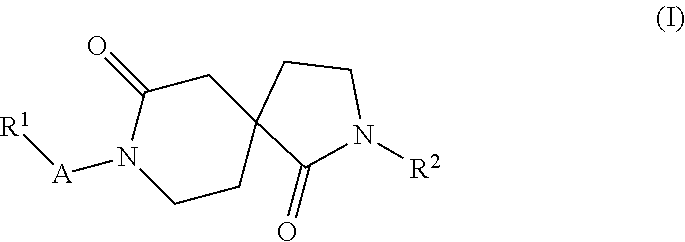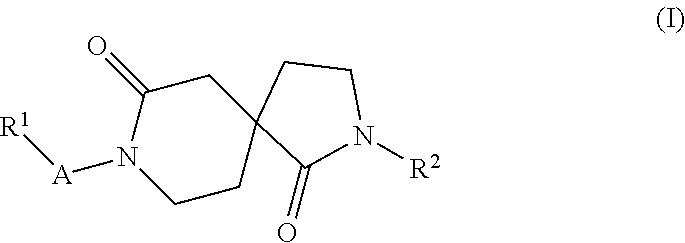New azacyclic derivatives
a technology of azacyclic derivatives and derivatives, applied in the field of organic compounds, can solve the problems of increased cardiovascular risk, decreased ffa release to the blood, and associated ffas
- Summary
- Abstract
- Description
- Claims
- Application Information
AI Technical Summary
Problems solved by technology
Method used
Image
Examples
example 1
8-Benzyl-2-(4-trifluoromethoxy-phenyl)-2,8-diaza-spiro[4.5]decane-1,7-dione
[0126]
Step A): 4-(2-Methoxy-ethyl)-piperidine-1,4-dicarboxylic acid 1-tert-butyl ester 4-ethyl ester
[0127]
[0128]LDA (2M solution in THF / heptane / ethylbenzene, 24.48 ml, 0.049 mol) was added under an argon atmosphere to THF (150 ml) at −5° C., piperidine-1,4-dicarboxylic acid 1-tert-butyl ester 4-ethyl ester (6.3 g, 6 ml) in THF (100 ml) was then added dropwise and the mixture was stirred for 2 hour at 0° C. Then 1-bromo-2-methoxy-ethane (6.8 g) was added at 0° C. and the mixture was stirred overnight at RT. The solvent was evaporated off, the residue partitioned between AcOEt and water. The layers were separated, the organic layer was washed with brine, dried over sodium sulphate and then concentrated to give 4-(2-methoxy-ethyl)-piperidine-1,4-dicarboxylic acid 1-tert-butyl ester 4-ethyl ester (8 g) as a brown oil which was essentially pure and used in the next step without further purification. MS (ESI): 216....
example 2
8-Propyl-2-(4-trifluoromethoxy-phenyl)-2,8-diaza-spiro[4.5]decane-1,7-dione
[0136]
Step A): 4-(2-Methoxy-ethyl)-2-oxo-1-propyl-piperidine-4-carboxylic acid ethyl ester
[0137]
[0138]To NaH (0.38 g, 55% suspension in oil), washed twice with pentane (each 6 ml), was added at RT under an argon atmosphere 4-(2-methoxy-ethyl)-2-oxo-piperidine-4-carboxylic acid ethyl ester (0.4 g) in THF (15 ml) and the mixture was stirred at RT for 5 minutes. Then 1-bromopropane (1.073 g) was added in one portion and the mixture was stirred over night at RT until completion of conversion according to mass spectroscopy. The reaction was quenched with 3M aqueous HCL (5 drops) and the reaction mixture was then partitioned between AcOEt and water. The layers were separated, the organic layer was washed with brine and dried over magnesium sulphate. The solvent was evaporated off to give the desired product as a light yellow semi-solid (0.2 g) which was directly used in the next step without further purification. M...
example 3
8-(2-Chloro-benzenesulfonyl)-2-(4-trifluoromethoxy-phenyl)-2,8-diaza-spiro[4.5]decane-1,7-dione
[0140]
[0141]2-(4-Trifluoromethoxy-phenyl)-2,8-diaza-spiro[4.5]decane-1,7-dione (0.105 g), product of example 1 step D), was dissolved in dry THF (10 ml), cooled to −78° C. under an argon atmosphere, treated dropwise with n-butyllithium (1.6 molar solution in hexanes, 0.22 ml) and then stirred for 20 minutes at −78° C. 2-Chlorobenzenesulfonyl chloride (0.074 g) in THF (2 ml) was then added dropwise, the mixture was stirred 15 minutes at −78° C., the cooling bath was removed and stirring was continued for further 75 minutes, allowing the temperature of the reaction mixture to rise to RT. The reaction mixture was then concentrated in vacuo, the residue adsorbed on silica gel and chromatographed on silica gel (AcOEt / heptane, gradient from 0 to 30%) to give the desired product (0.051 g) as an off-white solid. MS (ESI): 503.0 (MH−).
PUM
| Property | Measurement | Unit |
|---|---|---|
| temperature | aaaaa | aaaaa |
| temperature | aaaaa | aaaaa |
| volume | aaaaa | aaaaa |
Abstract
Description
Claims
Application Information
 Login to View More
Login to View More - R&D
- Intellectual Property
- Life Sciences
- Materials
- Tech Scout
- Unparalleled Data Quality
- Higher Quality Content
- 60% Fewer Hallucinations
Browse by: Latest US Patents, China's latest patents, Technical Efficacy Thesaurus, Application Domain, Technology Topic, Popular Technical Reports.
© 2025 PatSnap. All rights reserved.Legal|Privacy policy|Modern Slavery Act Transparency Statement|Sitemap|About US| Contact US: help@patsnap.com



